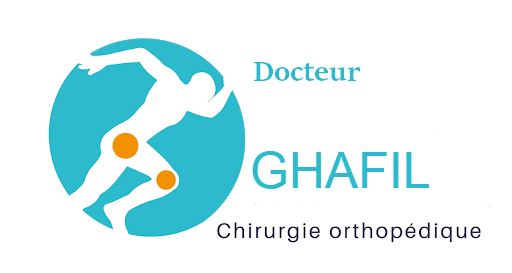OSTEOARTHRITIS OF THE HIP JOINT
Osteoarthritis of the hip joint
Osteoarthritis of the hip is cartilage wear of the joint.


Coxarthrosis: cartilage wear
It can be primary and develops after the age of 60, with unknown etiology or secondary to trauma, infection, inflammatory diseases, avascular necrosis or congenital malformation. Osteoarthritis of the hip is a frequent disorder and affects both sexes equally.
Clinical features
The pain in hip osteoarthritis is typically located in the groin area and may radiate down the thigh to the knee. Pain occurs mainly during walking, but can also occur at night. The joint gradually becomes stiff over time.
TrEATment
Although there is no cure for osteoarthritis, there are number of treatment options, both surgical and non-surgical, that will help relieve pain and improve mobility. The treatment depends on the stage of the disease and degree of severity.
What are the different levels of treatment for hip osteoarthritis ?
- In the case of overweight individuals, weight loss can be beneficial. Use of a support device (cane or crutch) can also help relieve pain while walking.
- Taking non-steroidal anti-inflammatory drugs (ex: Diclofenac).
- Physiotherapy, mesotherapy, etc…
- Intra-articular injections: these injections are performed under local anesthesia and under radiographic guidance. We can inject either a corticosteroid anti-inflammatory or hyaluronic acid.
- The total hip prosthesis: if conservative therapy fails to improve symptoms, the decision to proceed with a total hip prosthesis must be made in agreement with the patient, typically when osteoarthritis is in the advanced stage (destruction of the articular surfaces).
What is a total hip replacement ?
It’s an artificial joint which replaces the worn parts of the joint and allows it to function painlessly.


Total hip prosthesis (metal and ceramic)
Are there different types of prostheses ?
The differences are primarily in the level of the friction torque (articulated parts of the prosthesis):
– Metal / Metal (rarely used today).
– Metal or Ceramic / Polyethylene (most often used in the elderly, above the age of 76).
– Ceramics / Ceramics (most often used in young people below the age of 65).
The advantages and disadvantages of each friction torque will be discussed during the consultation with your orthopedic surgeon.
Pre-operative assessment
Before the total hip replacement procedure, the patient must undergo additional examinations including x-rays and blood tests, as well as a visit to the anesthesiologist.
What type of anesthesia ?
This depends on the type of surgical approach to the hip joint. If the prosthesis is placed through a posterior approach, a spinal anesthesia (epidural), in order to anesthetize the lower part of the body, or general anesthesia can be performed.
If the prosthesis is placed through an anterior approach, general anesthesia is necessary.

Posterior approach
If the prosthesis is placed through an anterior approach, general anesthesia is necessary.

Anterior approach
What are the advantages of the anterior approach in performing a total hip prosthesis ?
I have been using the anterior approach for all primary hip prostheses since 2002. It is a minimally invasive technique, as it eliminates the need for muscle or tendon division.This muscle preservation contributes to faster postoperative rehabilitation. In addition, the anterior approach allows less postoperative dislocations (less than 1%) compared to the other approaches .
How does the prosthesis attach to the bone ?
Most often the prosthesis is fixed to the bone by a layer of hydroxyapatite, which is a layer of material that allows bone-prosthesis integration.


Hip prosthesis (Hydroxyapatite coating)
Less frequently, the implant is fixed to the bone using cement, which is a kind of biologic glue. This method of fixation is mainly used in revision procedures.
How long the operation takes ?
For a primary procedure, the operating time is between 1-1.5 hours.
What happens after the operation ?
If the operation is performed in the morning, functional rehabilitation begins the same afternoon and otherwise begins the following day. The patient will be able to walk bearing full weight on the hip with or without the use of crutches and the help of a physiotherapist. The patient will remain hospitalized for two to four days and then return home or transition to a rehabilitation center if the conditions do not allow an immediate return to home.
What are the risks and potential complications after a total hip replacement ?
– Infection is a rare but serious complication. Administration of antibiotics just before starting the procedure significantly reduces this risk.
– Vein thrombosis (clot): This is a potentially serious complication because it can lead to a pulmonary embolism. In order to prevent this complication, daily subcutaneous injections are administered postoperatively in order to thin the blood and prevent clotting.
– Dislocation of the prosthesis: this rare complication can occur especially during the first few months after the operation. Using the anterior approach reduces this risk to less than 1% of cases.
– Loosening of the prosthesis: this is an especially late complication. The prosthesis is no longer fixed to the bone and this requires a revision.
Is physiotherapy needed after discharge ?
Usually hip replacement using the minimally invasive anterior approach doesn’t require physiotherapy because it’s a muscle sparing procedure allowing faster recovery. Nevertheless, if needed, a few sessions can be prescribed by your surgeon.
